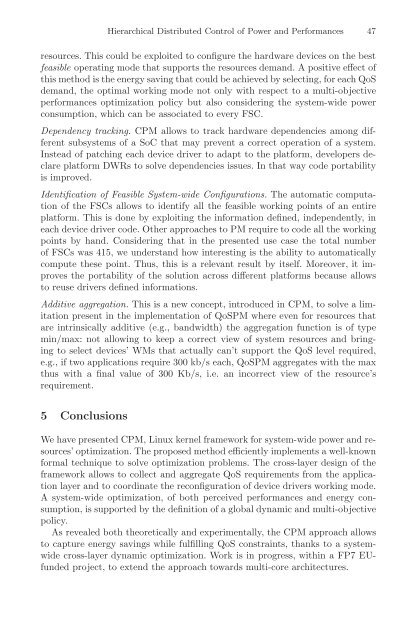Architecture of Computing Systems (Lecture Notes in Computer ...
Architecture of Computing Systems (Lecture Notes in Computer ...
Architecture of Computing Systems (Lecture Notes in Computer ...
Create successful ePaper yourself
Turn your PDF publications into a flip-book with our unique Google optimized e-Paper software.
Hierarchical Distributed Control <strong>of</strong> Power and Performances 47<br />
resources. This could be exploited to configure the hardware devices on the best<br />
feasible operat<strong>in</strong>g mode that supports the resources demand. A positive effect <strong>of</strong><br />
this method is the energy sav<strong>in</strong>g that could be achieved by select<strong>in</strong>g, for each QoS<br />
demand, the optimal work<strong>in</strong>g mode not only with respect to a multi-objective<br />
performances optimization policy but also consider<strong>in</strong>g the system-wide power<br />
consumption, which can be associated to every FSC.<br />
Dependency track<strong>in</strong>g. CPM allows to track hardware dependencies among different<br />
subsystems <strong>of</strong> a SoC that may prevent a correct operation <strong>of</strong> a system.<br />
Instead <strong>of</strong> patch<strong>in</strong>g each device driver to adapt to the platform, developers declare<br />
platform DWRs to solve dependencies issues. In that way code portability<br />
is improved.<br />
Identification <strong>of</strong> Feasible System-wide Configurations. The automatic computation<br />
<strong>of</strong> the FSCs allows to identify all the feasible work<strong>in</strong>g po<strong>in</strong>ts <strong>of</strong> an entire<br />
platform. This is done by exploit<strong>in</strong>g the <strong>in</strong>formation def<strong>in</strong>ed, <strong>in</strong>dependently, <strong>in</strong><br />
each device driver code. Other approaches to PM require to code all the work<strong>in</strong>g<br />
po<strong>in</strong>ts by hand. Consider<strong>in</strong>g that <strong>in</strong> the presented use case the total number<br />
<strong>of</strong> FSCs was 415, we understand how <strong>in</strong>terest<strong>in</strong>g is the ability to automatically<br />
compute these po<strong>in</strong>t. Thus, this is a relevant result by itself. Moreover, it improves<br />
the portability <strong>of</strong> the solution across different platforms because allows<br />
to reuse drivers def<strong>in</strong>ed <strong>in</strong>formations.<br />
Additive aggregation. This is a new concept, <strong>in</strong>troduced <strong>in</strong> CPM, to solve a limitation<br />
present <strong>in</strong> the implementation <strong>of</strong> QoSPM where even for resources that<br />
are <strong>in</strong>tr<strong>in</strong>sically additive (e.g., bandwidth) the aggregation function is <strong>of</strong> type<br />
m<strong>in</strong>/max: not allow<strong>in</strong>g to keep a correct view <strong>of</strong> system resources and br<strong>in</strong>g<strong>in</strong>g<br />
to select devices’ WMs that actually can’t support the QoS level required,<br />
e.g., if two applications require 300 kb/s each, QoSPM aggregates with the max<br />
thus with a f<strong>in</strong>al value <strong>of</strong> 300 Kb/s, i.e. an <strong>in</strong>correct view <strong>of</strong> the resource’s<br />
requirement.<br />
5 Conclusions<br />
We have presented CPM, L<strong>in</strong>ux kernel framework for system-wide power and resources’<br />
optimization. The proposed method efficiently implements a well-known<br />
formal technique to solve optimization problems. The cross-layer design <strong>of</strong> the<br />
framework allows to collect and aggregate QoS requirements from the application<br />
layer and to coord<strong>in</strong>ate the reconfiguration <strong>of</strong> device drivers work<strong>in</strong>g mode.<br />
A system-wide optimization, <strong>of</strong> both perceived performances and energy consumption,<br />
is supported by the def<strong>in</strong>ition <strong>of</strong> a global dynamic and multi-objective<br />
policy.<br />
As revealed both theoretically and experimentally, the CPM approach allows<br />
to capture energy sav<strong>in</strong>gs while fulfill<strong>in</strong>g QoS constra<strong>in</strong>ts, thanks to a systemwide<br />
cross-layer dynamic optimization. Work is <strong>in</strong> progress, with<strong>in</strong> a FP7 EUfunded<br />
project, to extend the approach towards multi-core architectures.


